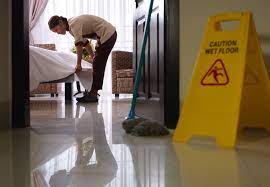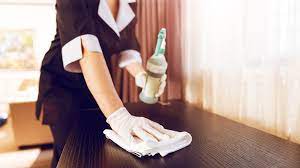CLEANING SCIENCE
Cleaning is carried out for the following reasons:-
a) Aesthetic appeal - The environment is made visually attractive and appealing
b) Hygiene - Effective, frequent cleaning controls, the growth and reproduction of pathogenic
bacteria and other germs.
c) Maintenance - Surface and articles, however good in quality will have a long and functional
life only when they are cleaned on regular basis.
d) Safety - Cleaning is done for safety against health hazards, fire hazards and slip hazards.
Types of soil:-
a) Dust- This is composed of loose particles deposited from the air. It contains both organic
(human and animal hair, dead skin cells, plants) and inorganic (sand, dry earth) matter.
b) Dirt - This implies dust held together firmly by moisture or grease on rough surfaces.
c) Tarnish - This is a discoloration or deposition on a metal or alloy surface caused by chemical
reaction with certain substances found in air, water and food stuffs. Different types of metals
get tarnished when they are exposed to air (copper gets a greenish color called 'verdigris').
d) Stain - This is discoloration caused on a hard or soft surface by a substance containing dyes,
proteins, acids or alkalis. Stains cannot be removed by routine cleaning process. It must be
removed as soon as they occurred, by using solvents to dissolve it or an acid or alkaline to
neutralize it.
e) Foreign matters -These may be dead flowers, contents of wastepaper basket and ashtrays, as
well as stains from the deposition of foreign substances (as opposed to the result of a chemical
reaction).
f) Grime: dirt ingrained on the surface of something.
Nature of soil:- All the above types of soil may be categorized under at least one of the
following heads, depending on the nature of the substance responsible.
a) Inorganic or mineral: A homogeneous chemical element or compound, solid, liquid or
gaseous substance, having a chemical composition resulting from the inorganic processes of
nature.
b) Organic: A substance that has a plant or animal origin. Organic compounds are basically
hydrocarbons i.e. they essentially contain the elements like carbon, hydrogen & oxygen.
c) Cosmological: these are substances containing either organic or inorganic matter that emit
an unpleasant odor.
d) Bacterial: some soils may contain live bacteria or their spores, which may cause diseases or
infections.
e) Entomological: These soils harbor insects, especially those that are carriers of disease &
infection.
Principles of cleaning:- These are the basic rules to follow in any kind of cleaning activity, whatever the nature of
surface or the soil.
1. All soil should be removed.
2. Soil should be removed without harming the surface being cleaned or the surrounding
surfaces.
3. The surface should be restored to its original state after the cleaning process.
4. The simplest method should be tried first using the mildest cleaning agent
5. Cleaning should proceed from high to low wherever possible
6. While wet cleaning or polishing the floor, the cleaner should walk backwards while
cleaning in front of him.
7. Suction cleaning should be preferred over sweeping wherever possible
8. Sweeping should be done before dusting and dusting before suction cleaning
9. Stains should be removed as soon as they occur
10. The cleaner should take all safety precautions while cleaning. In particular, cleaning
agents and equipment should be stacked neatly to one side.
11. The cleaner should start cleaning from the farthest end of an area working towards the
exit.
Methods of cleaning:-
MANUAL METHODS
a) Sweeping
b) Dusting
c) Damp Dusting
d) Moping
e) Scrubbing
f) Polishing
MECHANICAL METHODS
a) Suction Cleaning
b) Buffing
c) Polishing
d) Burnishing
e) Scrubbing
f) Stripping
Sweeping: This is done to collect dust when the floor surface is too rough for a dust mop
Dusting: This is fine, dry powder consisting of tiny particles of earth or waste matter lying on
the ground or on surfaces or carried in the air.
Damp dusting: This is the most preferred way of cleaning in hotels as surfaces can be wiped
as well as dusted, removing any stick or dirty mark at the same time.
A suitable lint-free cloth at the correct level of dampness should be used so as to avoid
leaving any smears.
Moping: This is the preferred way to remove dust, sand or grit from the floor
Scrubbing: This is the process to remove dirt, grime, etc. from something by hard rubbing
while washing/ cleaning.
Polishing: This process uses soft pad or brush to remove some soil and put the shine back
on the surface.
Buffing: In this process surface is rubbing with a piece of soft material in order to make it
shine.
Suction cleaning: Vacuuming with high-filtration machines to remove dry-soil form the
surface.
Burnishing: This process uses an ultra-high-speed floor machine (1500-2500 rpm) to restore
a deep gloss to the floor finish.
Stripping: This refers to completely removing old wax, soil and debris found on the surface.
Cleaning and Hygiene Principles
The housekeeper must follow the given principles while cleaning −
Carry out the cleaning procedures in sequence. Say, sweeping → Dusting →
Mopping/Suction Cleaning → disinfecting → Air Freshening.
Must take care while cleaning and polishing; not to damage various surfaces and hamper
their appearance.
Should start cleaning from extreme inner end continuing towards exit.
Should park the chambermaid's trolley such that it leaves space for corridor traffic.
Must take proper precautions while handling cleaning equipment, detergents, and guest
luggage.
Must remove hard water stains and spider webs as soon as they occur.
Must never use guest room linen for cleaning or blocking room entry.
Safety and Security Principles
The housekeeper must follow the safety rules mentioned below −
Protect their body from harmful chemicals by wearing thick gloves.
Protect their eyes by wearing masks or goggles if required.
Must use of caution sign to mark wet floors.
Clean spilled liquids immediately to reduce chances of slipping.
Handle cleaning chemicals carefully while transporting, disposing, or refilling the containers.
Mix any chemicals required in the presence of proper ventilation.
Must not open unlabeled chemical containers.
Use swivel head mops to avoid inappropriate body posture while cleaning.
Wear close toe-non slip footwear while working.
Use appropriate body postures while working to avoid cramps.
Request for peer assistance while moving heavy loads such as furniture.
Report to the supervisor in case of any accident due to mishandling of flammable liquids or
otherwise.
Frequency of Cleaning-Cleaning tasks may be divided according to the frequency of their
scheduling, which depends upon:
The level of soiling,
1. The type of surface,
2. The amount of traffic,
3. The type of hotel, and
4. The cleaning standards set.
5. The greater the amount of soiling, the greater will be frequency of cleaning carried out.
Cleaning tasks are carried out as per one of the following frequency:-
6. Daily Tasks
7. Periodic Tasks
8. Special cleaning Task
9. Spring cleaning Task
1. Daily cleaning task: These are routine operations carried out on a day-to-day basis by
the staff of the housekeeping department. These include the regular servicing of
guestrooms, cleaning of bathrooms and toilets, suction-cleaning of floors and floor
coverings, and so on.
2. Periodic cleaning task: These are carried out on a weekly, monthly, quarterly (every
three months), half-yearly or annual basis. These may include the polishing of metal
surfaces, dusting of hard-to-reach areas, and so on.
3. Special cleaning task: Spring-cleaning is a special type of periodic cleaning. Some of the
usual periodic tasks in a hotel include the shampooing of carpets, washing of walls,
cleaning of chandeliers, and stripping and polishing of floors.
The higher the standards required, the greater is the task carried out daily and greater the
amount of soiling, the greater will be frequency which is carried out.
Design Features that simplify Cleaning
1. Smooth textures; straight, neat, and smooth lines; and medium toned colors are some of
the design features in a surface that make for easier cleaning.
2. Surfaces with these features collect less dust compared to surfaces with rough textures,
intricate raised patterns, and grooves.
3. Medium-toned colors show less dirt than surfaces of darker or lighter shades.
4. Furniture should be so designed that cleaning under and behind them is easy.
5. Furniture on castor wheels and glides are easily movable, making cleaning under and
behind them easier.
6. Bed frames should not have a raised edge. Though raised edges help to keep the mattress
sunk in place, they may graze the hands of GRAs badly during bed-making.
7. With regard to carpets, the shorter the carpet pile, the easier the cleaning.
8. Upholstery too should have the minimum of decorative features such as buttons, gathers,
etc.
9. Surfaces such as solid wood are now being substituted by laminates wherever possible.
10. While solid wood requires regular buffing and polishing, laminates are low-maintenance
surfaces.
11. A regular damp-dusting is usually sufficient for laminates. The drawback of laminates is that
they lack the richness and elegance of solid wood.
12. Wood-polishes are stain-resistant and long-lasting, are a boon to housekeepers as wooden
surfaces become fairly easy to maintain with the use of these polishes.
13. Another high-maintenance surface that requires constant polishing is brass.
14. Brass becomes easily tarnished, and more so in coastal climates.



 Create and manage your profile
Create and manage your profile Refer an author and get bonus Learn more
Refer an author and get bonus Learn more Publish any lost and found belongings
Publish any lost and found belongings Connect with the authors & add your review comments
Connect with the authors & add your review comments Join us for Free to advertise for your business or
Contact-us for more details
Join us for Free to advertise for your business or
Contact-us for more details
 Join us for Free to publish your own blogs, articles or tutorials and get your
Benefits
Join us for Free to publish your own blogs, articles or tutorials and get your
Benefits

 6 likes
6 likes


